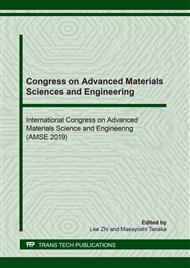p.52
p.58
p.64
p.70
p.79
p.84
p.90
p.99
p.105
3D Printed Titanium Dioxide Thin Films for Optoelectronic Applications
Abstract:
This work focused on the printing of semiconductor TiO2 thin films for solar cell applications by 3D printing system. We demonstrate a Liquid Deposition Modeling (LDM) type for controlling the pattern of TiO2 electrode. The advantage of this type of printer is able to vary the numbers of printed layer as well as different levelling pattern of TiO2 thin films by one time operation. Our aim was to study the effects of operating parameters of the 3D printer, such as nozzle size, speed and pressure on the thickness and uniformity of the printed TiO2 films. Using a commercial TiO2 paste, TiO2 precursor films were deposited on a conductive F-doped SnO2 glass by adjusting nozzle size, speed and pressure. The precursor films with different printed layers and levelling pattern were sintered using oven to produce porous TiO2 electrodes. The thickness and surface roughness of obtained TiO2 electrodes were characterized using Scanning Electron Microscope (SEM) and 3D Measuring Laser Microscope. The printed TiO2 substrates were applied to dye-sensitized solar cells as electrodes. Our LDM type 3D printing will provide a new way of levelling design of device components for versatile optoelectronic applications.
Info:
Periodical:
Pages:
79-83
Citation:
Online since:
May 2020
Authors:
Keywords:
Price:
Сopyright:
© 2020 Trans Tech Publications Ltd. All Rights Reserved
Share:
Citation:


